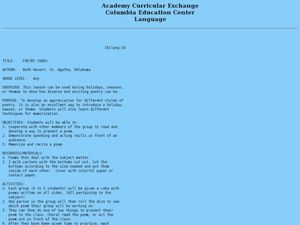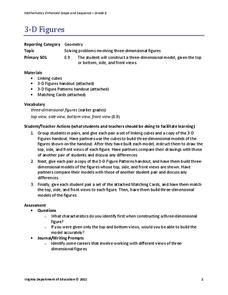Novelinks
The Book Thief: Cubing Strategy
Whether used to review prior to a reading assessment or as a way to generate ideas for an essay, this activity is sure to encourage critical thinking about Markus Zusak's The Book Thief. Kids create a six-sided question cube with each...
Curated OER
Poetry Cubes
Reading aloud can be scary, but it's an important way to build oral fluency. Break the class into groups of four or five learners. Each learner will roll a cube to determine which poem they read aloud to their small group. Feel free to...
Curated OER
Regarding the Fountain: Questioning Strategy—Cubing
Look deeper into the text with a reading strategy based on asking critical thinking questions. While reading Reading the Fountain by Kate Klise, learners think of questions that help them describe, compare, associate, analyze, apply, and...
Curated OER
Number Rods
Working in a math center or an "I finished early" work station, young mathematicians will match in sequence pre-set-up rods of unifix cubes to numbers on a number line. To help differentiate tens from ones, use different colors to...
Teaching Ideas
Volume
After understanding that the volume of a unit cube is one cubic centimeter, math masters determine the volume of four larger rectangular shapes. Then they take the challenge to figure out the volume of seven irregular, cube-containing...
Curated OER
Volume of Solid Figures
Learners calculate volume using the correct formula and the correct unit. They explore different prisms, spheres, cubes, and cones as they calculate volume and relate it to depths in oceans.
Curated OER
Scientific Method Experiment: Factors Affecting How Ice Melts
Students demonstrate the scientific method by conducting an ice cube melting experiment. They make predictions and observations, and conclude what factors make ice melt more slowly or quickly than normal.
World Wildlife Fund
Shapes
Investigate the properties of three-dimensional figures with this Arctic-themed math lesson. Beginning with a class discussion about different types of solid figures present in the classroom, young mathematicians are then given a...
Illustrative Mathematics
Traffic Jam
Help your learners understand dividing with fractions by using these methods to solve. Chose from two different number lines or linker cubes. This practices "how many groups?" style division problems which help them comprehend why they...
American Chemical Society
What is Density?
Density: the reason a giant pumpkin will float, but a tiny cranberry won't. Lesson begins with a demonstration of two of the same-sized cubes having different densities. Then pupils take eight cubes, each of the same size, and have to...
Curated OER
Rational Exponents
Investigate rational exponents in this math instructional activity. Scholars make conjectures about the relationship between rational exponents and radicals. They then use their Ti-Nspire to simplify rational exponents.
Curated OER
Painted Cube Lesson
Learners differentiate between cubes and unit cubes. In this geometry activity, students create linking cubes and use it as a manipulative to answer questions. They define the faces, edges and sides of the cubes as it relates to unit cubes.
Curated OER
Why Do Ice Cubes Melt?
First graders investigate water properties by participating in a hands on experiment. In this ice formation lesson, 1st graders examine real ice cubes in a bowl and identify the reasons why certain cubes melt faster than others. Students...
Curated OER
America's Civil Rights Movement, Cubing
Students explore cubing as a graphic organizer to better explain the key concepts of the Civil Rights Movement and take positions on key concepts regarding the Movement.
Curated OER
Building a Box
Students create different two dimensional nets that can be folded to create a cube. In this visual spacial awareness lesson, students explore different ways that two-dimensional objects can be laid out to create a three dimensional cube.
Curated OER
New Boxes From Old
Middle schoolers find the volume and surface area of a rectangular box (e.g., a cereal box), and then figure out how to convert that box into a new, cubical box having the same volume as the original. As they construct the new,...
Curated OER
What to Do with Leftovers
Second graders solve real world division story problems using unifix cubes. They read "A Remainder of One" and discuss the concept of remainders. They solve the division problems first with the cubes and then write the problem and answer...
Curated OER
The Five Number Game
Students explain what it means to square numbers. They explain what it means to cube numbers. Students define prime numbers using their own language. They are introduced to the problem by playing one game as a class.
Curated OER
Geometry and Rubik's Cube
Students explore geometry using a Rubik's Cube. In this 2-D and 3-D shapes lesson, students use the Rubik's Cube to find the center, edge and corner pieces. Students then find the dimensions of the Rubik's Cube and read the solution...
Curated OER
Surface Area
Sixth graders compute the surface area. In this surface area lesson students are given a set of problems to calculate. They compute the surface area of cubes and rectangular boxes.
Curated OER
Making Patterns - Create, Analyze, and Predict
Fourth graders practice making patterns using Unifix cubes and identify, analyze, and determine rules for describing numerical patterns involving operations and nonnumerical growing patterns. They also find an example of a pattern in...
Virginia Department of Education
3-D Figures
Scholars construct three-dimensional figures to study dimension and side views. Learners build models using linking cubes to match views of different sides. After practicing with models, they attempt to match three-dimensional drawings...
Learner
Solid Shapes
A collection of two lessons, kindergartners will identify two-dimensional shapes in solid shapes. They will develop basic knowledge of the components that make up a sphere, rectangular prism, pyramid, cylinder, cone, and cube. Young...
Curated OER
Math Cubes
Students practice addition and subtraction while making and then playing a game. For this addition and subtraction lesson, students will make dice using a cube tracer and number and number sign tracers to make the numbers and number...
Other popular searches
- Unifix Cubes
- Counting Cubes
- Counting Cubes Worksheets
- Connecting Cubes
- Fraction Tower Cubes
- Snap Cubes
- Addition Using Unifix Cubes
- Volume by Counting Cubes
- Isometric Cubes
- Pop Cubes
- Counting Cubes and Sorting
- Counting Cubes for Area

























